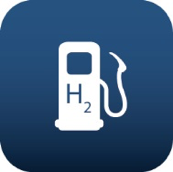 Leak Testing of Hydrogen Tanks for FCVs
Leak Testing of Hydrogen Tanks for FCVs
Description of Technical Challenge
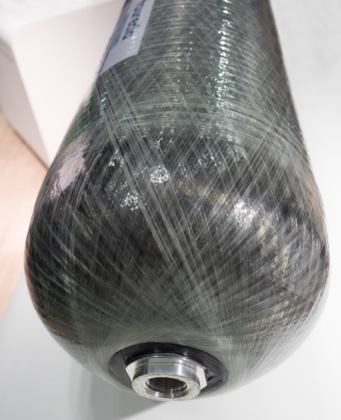
Type IV composite tanks are typically used for hydrogen storage in fuel cell vehicles.
Fuel cell vehicles (FCVs) typically use Type IV tanks for hydrogen storage. Type IV tanks are composite tanks of carbon fiber with a polymer liner. Storage pressure is typically in the range of 300 – 700 bar.
Safety regulations (ISO/TS 15869) require that hydrogen tanks are tested for leakage / permeation. Leak / permeation rates are measured as Normal liter of H2/time in hr/volume of the tank. The maximum allowable leak rate typically is defined as 1 scc / hr / l volume.
Example:
A 30 liter hydrogen tank must not leak / permeate more than

The INFICON Solution
Integral testing of tank body
The required leak rates may indicate that these could be detected with pressure leak testing (pressure decay). However, this proves to be impossible due to the rather large volume of the parts. Any minimal change in temperature during the testing cycle – even with temperature compensation - will result in a rather large change in pressure, either causing a false positive or hiding a potential leak.
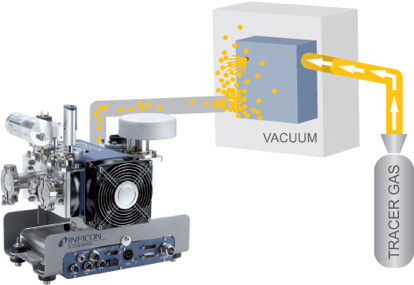
Hydrogen tank bodies are tested by vacuum chamber testing for high volume manufacturing.
In high volume production, hydrogen tanks are typically tested via helium vacuum chamber leak testing to achieve short cycle times and high throughput. Due to the large volume of the tanks and the rather large allowable leak rates, typically helium mixed with air is used as tracer gas. The hydrogen tank is filled with a small amount of helium first and then backfilled with air to operating pressure so that the resulting gas mixture in the tank contains about 5 – 10% helium. The hydrogen tank is then placed in a vacuum chamber. The chamber is evacuated and once the final vacuum pressure is reached, an LDS3000 leak detector is connected to the vacuum chamber and helium escaping from the hydrogen tank is detected by the LDS3000. The threshold leak rate needs to be adapted to the used helium concentration in the tracer gas. The used tracer gas can be reclaim for consequtive testing.
TIP
Helium tracer gas from leaks escapes quickly and causes a fast rise of the signal, whereas helium permeates through the skin of the hydrogen tank rather slow and causes a delayed rise of the signal.
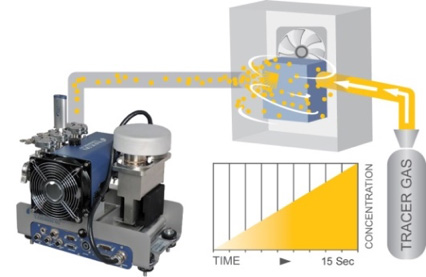
Hydrogen tank bodies are tested in an accumulation chamber in low volume manufacturing.
For low volume production, hydrogen tanks may also be tested by accumulation leak testing. Accumulation testing allows for the use of either helium, typically again mixed with air to save cost, or forming gas, a non-flammable 5% hydrogen in 95% nitrogen gas mixture. The hydrogen tank is filled with the required amount of tracer gas first. The hydrogen tank is then placed in an accumulation chamber. In case of a leak, the escaping tracer gas will cause a rise of concentration in the accumulation chamber. This rise in concentration is detected by an LDS3000 AQ leak detector.and an alarm is given if a threshold leak rate is exceeded. The threshold leak rate needs to be adapted to the used helium concentration in the tracer gas. The used tracer gas can be reclaim for consequtive testing.
Leak testing of assembled hydrogen tanks
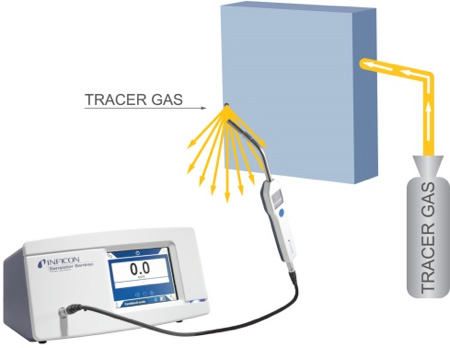
Assembled hydrogen tanks are often tested by hydrogen sniffing.
Once the hydrogen tank body is assembled with fittings and connectors, these joints are tested for leaks typically by hydrogen sniffing. Also welds of different parts of the body can be tested this way.
For the sniffing test the assembled hydrogen tank is filled with forming gas – a non-flammable 5% hydrogen in 95% nitrogen gas mixture. The sniffer probe of a Sensistor Sentrac hydrogen leak detector is then guided along potential leak locations. If forming gas escapes from any leaks, it is detected by the sniffer probe and the leak detector will alarm. This allows for the leaks to be exactly located and the leak location can be reported to any rework stations.
Benefits of Leak Testing with Tracer Gas
- High reliability of leak detection
- Repeatable and reproducible process
- Results traceable to national standards
- No influence of temperature or humidity
For more information, please visit us at www.inficonautomotive.com or call your nearest sales representative.
